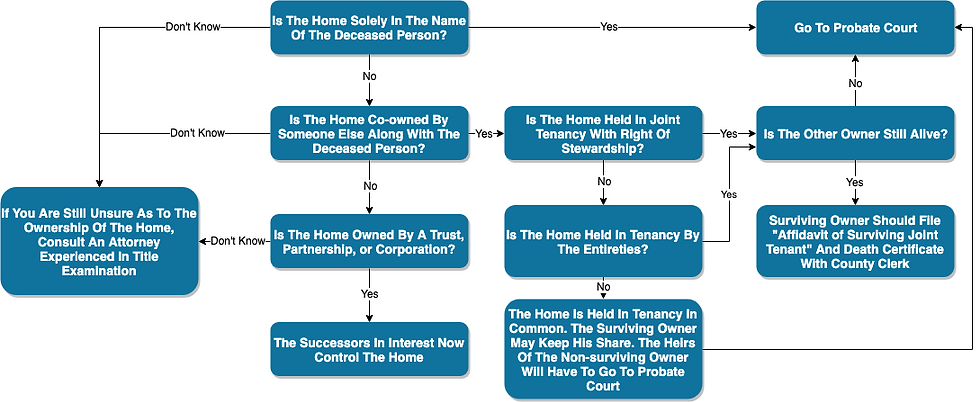When a Homeowner Dies, What Happens to the House?
- Kyle Persaud

- Apr 8, 2019
- 4 min read
Updated: Aug 31, 2020
In last week’s blog post, we discussed what happens to a motor vehicle when the vehicle owner dies. Here, we will discuss what happens to a home, when the homeowner dies.
You have a relative who owned a home, and your relative is deceased. You may be asking: Who owns the home now? How do I sell the home?
First, find the original deed (or document) that originally transferred the home to your deceased relative. You may have to go to the office of the county clerk to find this document.
Then look at the deed. When you look at the deed, ask the following questions:
1. Does the deed transfer the home solely to the now-deceased person?
2. Does the deed transfer the home jointly, to the now-deceased person, and another person?
3. Does the deed transfer the home to a trust, partnership, or corporation?
· Does the deed transfer the home solely to the now-deceased person?
If the deed transfers the home solely to the now-deceased person, (and the home was not co-owned by any other person) then, you will have to file a case in probate court, to get the home out of the decedent’s name. If the decedent had a will, the probate court will transfer the home to whomever the decedent named in his will. If the decedent died without a will, the probate court will transfer the home to the decedent’s next of kin, according to the Oklahoma Intestate Succession Law. Click here to see the Oklahoma Intestate Succession Law.
· Does the deed transfer the home jointly, to the now-deceased person, and another person?
Look at the language on the deed. Do you see the language “joint tenancy” or "right of survivorship” or “tenancy by the entirety”?
If the language “joint tenancy” or “right of survivorship” is in the deed, then, that means, that, when one owner dies, the surviving owner or owners automatically become the owner of the property. All that the surviving owner(s) need to do, is file an “affidavit of surviving joint tenant” with the county clerk. Attach a certified copy of the decedent’s death certificate to this “affidavit of surviving joint tenant.” Then, the surviving owner(s) are the owner(s) of the home.
A tenancy by the entirety can only exists between persons who are married to each other. If the language “tenancy by the entirety” is in the deed, then, the surviving spouse automatically becomes the owner of the property. All that the surviving spouse needs to do, is file an “affidavit of surviving tenant by the entirety” with the county clerk. Attach a certified copy of the decedent’s death certificate to this “affidavit of surviving tenant by the entirety.” Then, the surviving spouse is the sole owner of the home.
(Of course, if the language “joint tenancy” or “right of survivorship” or “tenancy by the entirety” is in the deed, and all of the owners are now deceased, you will have to go to probate court to get the home out of the name of the deceased persons.)
If the language “joint tenancy” or “right of survivorship” or “tenancy by the entirety” are not in the deed, then, the decedent and the survivor owned the property as “tenants in common.” In this case, after the decedent dies, the following are true:
1. The survivor still owns a partial interest in the property.
2. The decedent also still owns a partial interest in the property, and you will have to go to probate court to get the decedent’s interest out of the name of the decedent. If the decedent had a will, the probate court will transfer the decedent’s interest to whomever the decedent named in his will. If the decedent died without a will, the probate court will transfer the decedent’s interest to the decedent’s next of kin, according to the Oklahoma Intestate Succession Law. Click here to see the Oklahoma Intestate Succession Law.
For more information on the difference between joint tenancy, tenancy by the entireties, and tenancy in common, click on my post here.
· Does the deed transfer the home to a trust, partnership, or corporation?
This often happens. Suppose that your father, John Doe, owned the property, but, in the deed, the property was actually in the name of the “John Doe Revocable Trust.” Or, suppose that the property was actually in the name of a partnership or corporation in which John Doe had an interest.
In this case, after John Doe dies, the property is still in the name of the trust, partnership, or corporation. Find the documents of the trust, partnership, or corporation. Documents of trusts, partnerships, and corporations are not required to be made public, so you may not be able to find these documents on file with a public body. Family members, or others with an interest in the corporation, may have these documents. Look at the documents and see who are the beneficiaries of the trust, or who are the successors in interest of the partnership or corporation. These beneficiaries, or successors in interest, now have a controlling interest in the home.
Some of these steps are complicated, and you may need a lawyer to help you in this matter.
Here is a flowchart that tells what to do when a homeowner has died:





Comments